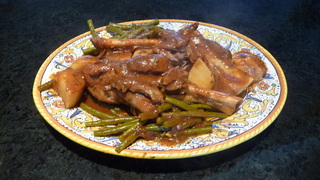As I mentioned before, braising is designed for cooking less tender cuts of meat, typically meat with extra fat. As the meat cooks in the braising liquid, often for two or more hours, the fat renders (melts), and the meat becomes fork tender (as the water soluble proteins dissolve). To avoid having the meat become so tender it just falls apart, it is best to cut the meat into large pieces – at least two inches on a side. Shanks, of course, are used whole. They are perfect for single servings.
As the meat cooks, the rendered fat will accumulate on the top of the braising liquid. This fat should be removed and discarded. The two day process offers the advantage of easily skimming the congealed fat from the chilled braising liquid before reheating it on serving day. When I use the single day approach, I use a meat baster to remove the hot liquid fat from the pot. A small gravy ladle works well, too.
Braising produces the best results when the braising liquid is richly flavored with a variety of root vegetables, herbs, and spices. In this regard, my braising recipes (and in fact, any braising recipe) should be considered as offering suggestions for preparing the braising liquid – not requirements. You may choose whichever vegetables, spices, and herbs you and your family prefer. When vegetables are used, however, they become mushy and tasteless during the extended cooking process. This is OK! They have “sacrificed” themselves to help create a delicious sauce. Consequently, I prefer to remove them after they have done their job. This is another entirely optional step, but I always strain the braising liquid whenever I use root vegetables or fresh herbs.
At the same time, I like the idea of vegetables in my sauces – particularly fresh vegetables. If you agree, there is another option you may wish to consider. After the sauce has been strained and thickened (if necessary), it will be deeply, and richly, flavored. When you get to the reheating step, you can “freshen” the sauce (think: add another layer of flavor) by reintroducing fresh, bite-sized portions of the same root vegetables used at the outset. Give the vegetables time to cook in the sauce before re-adding the meat (for reheating). Once again, this step is entirely optional.
If you've done any of this before, you already know how incredibly delicious braised meats can be. If you are braising for the first time, I assure you that you and your din companions are in for a special treat!
Buon appetito.

 RSS Feed
RSS Feed